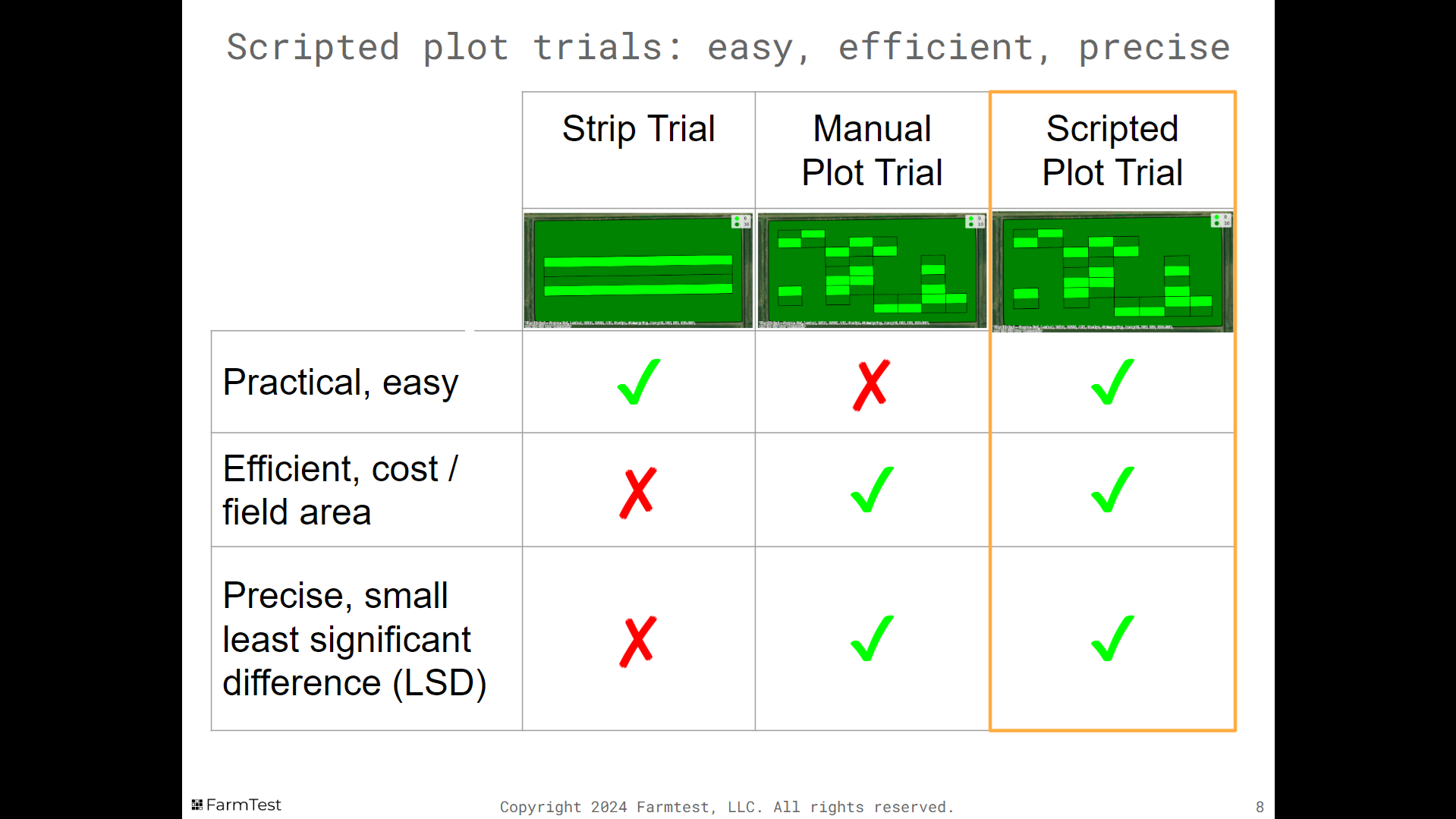Plots vs. Strips: 3 Reasons Plot Trials Deliver Better Accuracy in On-Farm Trials
When it comes to on-farm trials, growers commonly rely on strip trials and split-field trials as their go-to method to test how a specific product or method performs. While strip trials and split-field trials are practical and easy to implement, they often lack the precision required for straightforward decision-making. This is where plot trials come in—offering a more precise approach that can deliver better learning from your on-farm experiments.
Plot trials are conducted in small, defined sections of a field to assess the effects of various treatments, such as different crop varieties, fertilizers, or pest control methods. Randomized Controlled Trials (RCTs) are a standard in agricultural research for ensuring precision and reliability. RCTs involve randomly assigning different treatments to various plots within a field to eliminate bias and ensure that the results reflect the true effects of the treatments. This approach helps in making comparisons more reliable by controlling for variability.
Key Considerations for Conducting On-Farm Trials
Farm trials on commercial farms should meet three essential criteria:
Practicality and Ease: The trial should be simple to execute with minimal disruption to your farming operations.
Efficiency: The trial should make the best use of field area and resources, such as time and costs.
Precision: The trial should deliver precise results, with a small uncertainty or least significant difference (LSD) to straightforward decision making.
Strip Trials: Practical but Limited
Strip trials excel in practicality and ease. They involve applying different treatments in long, continuous strips across a field. This approach is easy to implement, making it a popular choice for farmers.
However, strip trials have notable downsides. They are less efficient and precise compared to other methods. While randomization—where treatments are assigned randomly—can help minimize bias, it may not always be effectively implemented in strip trials due to logistical constraints. Without proper randomization, strip trials can be susceptible to bias, making it more challenging to isolate the effects of each treatment. Additionally, because each treatment covers a larger area, the results can have a significant margin of error, making it hard to detect small differences in performance.
With only one strip in a field, it's also challenging to determine if observed differences are due to the treatments or random variation, as the test can't be repeated under the same conditions. Replication—repeating trials to estimate experimental error and enhance reliability—can help distinguish true effects from random variation. However, this approach requires more time and effort, which can be burdensome.
For example, suppose you’re running a strip trial in a 200-bushel-per-acre cornfield. Due to the larger area covered by each treatment, the data generated often has high variability, leading to an error margin of around 20%. This means your yield could vary by ±40 bushels per acre, making it difficult to detect smaller yield improvements.
Manual Plot Trials: Precise but Impractical
On the other hand, manual plot trials offer high efficiency and precision. By dividing a field into smaller plots and often using techniques such as blocking (grouping similar plots together to control for known sources of variability), the variability is reduced, leading to a much lower error margin. However, manual plot trials are often impractical for most commercial farms due to their complexity.
Scripted Plot Trials: Combining The Best of Both Worlds
FarmTest introduces Scripted Plot Trials, a third option that combines the accuracy of plot trials with the convenience of strip trials. Here’s why Scripted Plot Trials could be the best option for your farm:
Precision and Efficiency: By breaking your field into smaller plots, you significantly reduce yield variability and increase the accuracy of your results.
Practicality: FarmTest makes the process easy by encoding the complexity of plot trials into a variable rate prescription. This script is loaded into your equipment's rate controller, allowing you to execute the trial as easily as a normal field pass. Just plant, spray, or apply your treatment, and the rate controller takes care of the rest.
Reduce Uncertainty and Maximize Field Area: FarmTest’s plot trials offer much more precise results, with a lower error margin of about 2%, compared to the 20% margin in traditional strip trials. This precision helps you detect small differences in treatments, leading to better decision-making, optimized practices, reduced risks, and improved profitability and productivity.
Learn more about the advantages of plot trials over strip trials by watching our Plots versus Strips video.
Get Started with FarmTest
Start designing your free trial today: https://my.farmtest.ag/create-account
Or chat with an expert team member for personalized assistance: Schedule a Quick Chat
Ready to unlock your field’s full potential? Try out FarmTest today!


